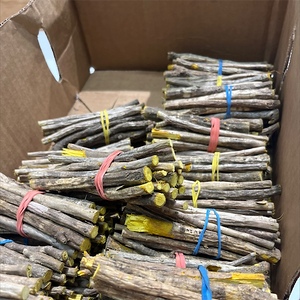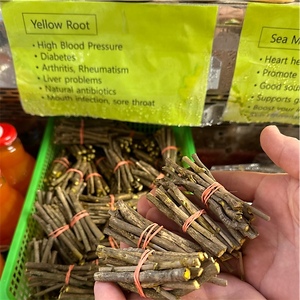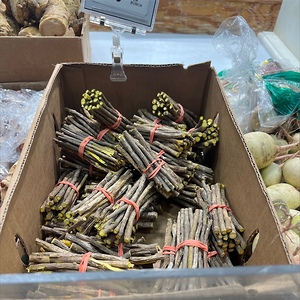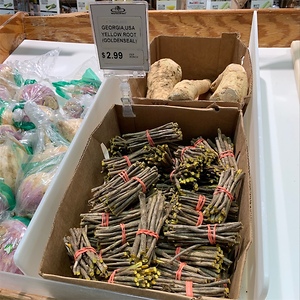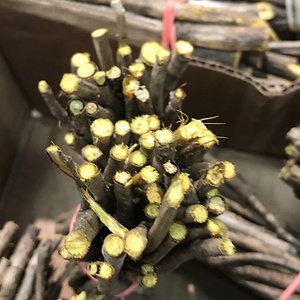

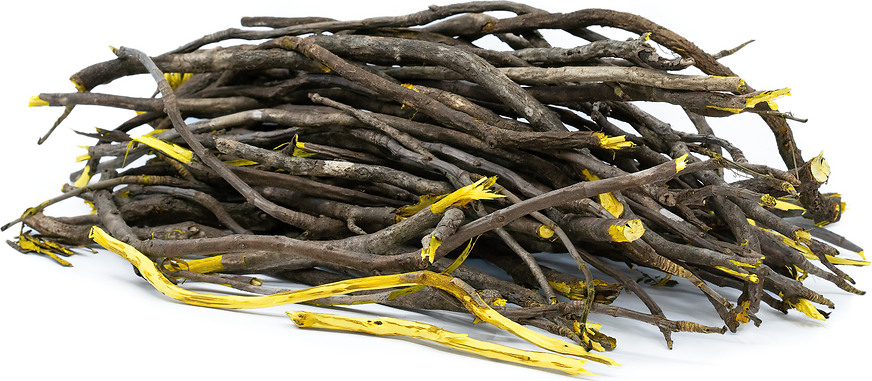
Yellowroot
Estimated Inventory, lb : 0
Description/Taste
Yellowroot is the rhizome of a small shrub, characterized by long, narrow stems. Its sturdy, woody stem supports clusters of light green leaves, each topped with five leaflets. These leaflets resemble celery leaves and feature a slightly toothed edge. Yellowroot can reach up to 30 centimeters tall and in the spring, tiny maroon flowers bloom from beneath the plant’s foliage. Yellowroot’s fruit forms a star-shaped cluster of green follicles that turn yellow as they mature. Its roots are long and thin, measuring around one centimeter in diameter. They have a bright yellow core and a bark-like exterior. Known for its earthy, woody, and slightly bitter smell, Yellowroot's taste is intensely bitter due to the alkaloid berberine. This bitterness limits its culinary use, but it is valued in traditional medicine for its potential therapeutic properties.
Seasons/Availability
Yellowroot can be found year-round.
Current Facts
Yellowroot, scientifically known as Xanthorhiza simplicissima, belongs to the Ranunculaceae or Buttercup Family, which mostly consists of leafy, flowering plants. Within this family's extensive diversity—over 43 genera and 2,000 species—Yellowroot is the only species in its monotypic genus. The term Xanthorhiza translates to "yellow root," and the plant is also known by several other names such as Brook-feather and Parsley-leaved Yellowroot. It’s historically used for both medicinal purposes and for making traditional baskets, feathers, and face paint in Native American cultures. Both Indigenous peoples of North America and African Americans have utilized Yellowroot extensively, integrating it into their traditional practices over generations.
Nutritional Value
Yellowroot contains berberine, an alkaloid known for its antibacterial, anti-inflammatory properties, and potential to lower blood pressure. Traditionally, it has been used topically for sore throats and eye infections, and internally for heart issues, diarrhea, and respiratory ailments. Yellowroot is often used as a cost-effective alternative to goldenseal, an herb used for its antimicrobial and immune-boosting properties. Both herbs share a similar appearance and contain berberine, which imparts a yellow color and bitter taste, and shows antimicrobial effects against various pathogens. However, it is critical to avoid ingesting yellowroot during pregnancy, as berberine can cross the placenta and is transferred through breast milk, potentially causing jaundice and kernicterus in newborns.
Applications
Yellowroot is primarily known for its medicinal rhizome, which is the underground part of the stem, commonly referred to as the root. These roots, which are not typically consumed whole but can be chewed, are rich in medicinal properties and are often used fresh or dried to make teas or tinctures. The active compound in Yellowroot, curcumin, has anti-inflammatory and antioxidant properties that support digestive health, reduce inflammation, improve gut flora, and enhance liver function. Dried Yellowroot can be stored for several months in an airtight container.
Ethnic/Cultural Info
Yellowroot has been used by Native Americans in the Appalachian region for thousands of years. The plant was first encountered by English speakers in 1773, when American botanist William Bartram discovered it along a creek in Buffalo Lick, Georgia. Bartram, known for his extensive explorations of the southeastern United States during the late 18th century, documented the region's flora, fauna, and the cultures of its Native American tribes during his travels. At the outset of his four-year journey through Southeast North America, William Bartram discovered a plant he described as 'a very curious Little Shrub,' now known as Yellowroot. Native Americans used Yellowroot for its health benefits and also utilized its berberine content as a dye. This practice was adopted by early American settlers. The dye's tendency to fade to an unattractive olive green in sunlight limited its popularity in the textile industry, leading to its decline in use.
Geography/History
Yellowroot is native to the United States in regions from Maine to Florida and west to Texas and Ohio. It thrives in cooler, temperate climates within moist, shaded environments such as riverbanks and damp wooded areas. It grew in popularity during the 1990s when rumors spread about its ability to mask drugs in urine tests, leading to a spike in its use as a herbal supplement. Since then, Yellowroot has been recognized for treating various ailments. While Yellowroot was once difficult to find at nurseries, it is now readily available. It can be foraged from natural habitats, cultivated in home gardens, and purchased at farmers' markets, where it is often sold in small, twine-wrapped bundles.



